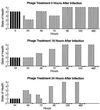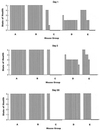Bacteriophage therapy rescues mice bacteremic from a clinical isolate of vancomycin-resistant Enterococcus faecium
- PMID: 11748184
- PMCID: PMC127648
- DOI: 10.1128/IAI.70.1.204-210.2002
Bacteriophage therapy rescues mice bacteremic from a clinical isolate of vancomycin-resistant Enterococcus faecium
Erratum in
- Infect Immun 2002 Mar;70(3):1664
Abstract
Colonization of the gastrointestinal tract with vancomycin-resistant Enterococcus faecium (VRE) has become endemic in many hospitals and nursing homes in the United States. Such colonization predisposes the individual to VRE bacteremia and/or endocarditis, and immunocompromised patients are at particular risk for these conditions. The emergence of antibiotic-resistant bacterial strains requires the exploration of alternative antibacterial therapies, which led our group to study the ability of bacterial viruses (bacteriophages, or phages) to rescue mice with VRE bacteremia. The phage strain used in this study has lytic activity against a wide range of clinical isolates of VRE. One of these VRE strains was used to induce bacteremia in mice by intraperitoneal (i.p.) injection of 10(9) CFU. The resulting bacteremia was fatal within 48 h. A single i.p. injection of 3 x 10(8) PFU of the phage strain, administered 45 min after the bacterial challenge, was sufficient to rescue 100% of the animals. Even when treatment was delayed to the point where all animals were moribund, approximately 50% of them were rescued by a single injection of this phage preparation. The ability of this phage to rescue bacteremic mice was demonstrated to be due to the functional capabilities of the phage and not to a nonspecific immune effect. The rescue of bacteremic mice could be effected only by phage strains able to grow in vitro on the bacterial host used to infect the animals, and when such strains are heat inactivated they lose their ability to rescue the infected mice.
Figures







References
-
- Ackermann, H.-W., and M. S. Dubow. 1987. Viruses of prokaryotes, p. 13–28. CRC Press, Inc., Boca Raton, Fla.
-
- Alisky, J., K. Iczkowski, A. Rapoport, and N. Troitsky. 1998. Bacteriophages show promise as antimicrobial agents. J. Infect. 36: 5–15. - PubMed
-
- Armitage, P. 1955. Tests for linear trends in proportions and frequencies. Biometrics 2: 375–386.
-
- Carlton, R. M. 1999. Phage therapy: past history and future prospects. Arch. Immunol. Ther. Exp. 47: 267–274. - PubMed
-
- Cimons, M. 1999. FDA approves the antibiotic Synercid for limited clinical uses. ASM News 65: 800–801.
MeSH terms
Substances
LinkOut - more resources
Full Text Sources
Other Literature Sources

